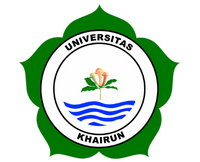The Influence of Shoot Location and Mechanical Treatment Following Grafting on Siamese Orange Seedling Development
Abstract
This study aims to determine the influence of the location of the buds and mechanical treatment after grafting on the growth of orange seedlings. The study used a Randomized Group Design (RAK), arranged factorially with nine combinations of treatments and three tests. The first treatment factor used is the budding eye system (P), consisting of 3 levels, namely P1: Fourth Budding Eye; P2: Fifth Budding Eye; and P3: Sixth Budding Eye. The second factor is mechanical treatment after grafting (K) consisting of 3 levels, namely K1: Rootstock Cutting; K2: Rootstock Restraint; and K3: Rootstock Bending. The parameters observed are the percentage of grafting of living plants, the time of bud exit, the number of leaf blades, the twisting of the stem of the grafting bud, and the length of the grafting bud. Based on the observations on the percentage of grafting that live after mechanical treatment of all budding eye location treatments, it shows that the fifth bud (P2) location treatment gives a higher rate of live grafting, which is 100% compared to other treatments. The treatment of the location of the fifth bud gives the best results against the time of bud exit, the number of leaves, the twisting of the grafting stem and the length of the grafting bud. Mechanical treatment of rootstock restraint after grafting gives the best results against the time of bud exit, the number of leaves, the twisting of the grafting stem and the length of the grafting bud. The interaction between the treatment of the fifth bud location treatment and the mechanical treatment of rootstock holding gave the best results against the growth of Siamese orange seedlings.
Keywords
Full Text:
PDFReferences
Aluhariandu, V. E., Tariningsih, D., dan Lestari, P. F. K. (2016). “Analisis Usahatani Jeruk Siam dan Faktor–Faktor Yang Memepengaruhi Penerimaan Petani (Studi Kasus di Desa Bayung Gede Kecamatan Kintamani Kabupaten Bangli)”. Agrimeta. Vol. 6 No. 12 Hal. 77–86.
Antarlina, S. S., Achmadi, Y., Rina, Noorginayuwati. I. N. W., Anisa, E., Maftuah, Muhammmad, M., Saleh, dan Budiman, A. 2016. “Hubungan Sifat Kimia Tanah Dengan Kualitas Jeruk di Lahan Pasang Surut”. Laporan Hasil Balittra. BBPPS. Banjarbaru.
Bakarudin. 2014. “Keberhasilan Okulasi Bibit Durian pada Model Mata Tempel dan Stadia Entres yang berbeda”. Thesis. Universitas Islam Negeri Siltan Syarif Kasim. Riau. Pekanbaru.
Budiyanto. 2013. “Proses Pembuatan Bibit Dengan Cara Penempelalan Tunas (Okulasi)”. www. Budisma.web.id.
Hariyadi, M., Firmansyah, F., dan Rahmawati, E. 2020. “Analisis Usaha tani Jeruk Siam dengan Sistem Pola Tanam Monokultur di Kecamatan Sungai Pinang, Kabupaten Banjar”. Frontier Agribisnis. Vol. 1 No.4 Hal. 129-135.
Primilestari, S., dan Purnama, H. 2019. “Teknologi Budidaya Jeruk Di Lahan Gambut Untuk Meningkatkan Produktivitas dan Pendapatan Petani di Kabupaten Tanjung Jabung Barat”. Prosiding Seminar Nasional Lahan Suboptimal, September. Hal. 978–979.
Qomariah R, Hasbianto, A., Lesmayati, S., dan Hasan H. 2013. “Kajian Prapanen Jeruk Siam (Citrus Suhuiensis Tan) untuk Ekspor”. Seminar Nasional Inovasi Teknologi Pertanian. Balai Pengkajian Teknologi Pertanian Kalimantan Selatan (ID). Hal. 417- 430.
Rini, S., dan Sumarjono. 2015. “Peluang Usaha Tanaman Jeruk”. Penebar Swadaya. Jakarta. Hal. 124.
Setiawan A. I. 2016. “Peluang Usaha Dan Pembudidayan Jeruk Siam”. Penebar Swadaya Jakarta.
Supriono. 2015. “Peranan Asam Absisat Pada Tanamaan”. Buletin pertanian. Hal 83.
Tarigan, R. 2018. “Analisis Pendapatan dan Efesiensi Usahatani Jeruk Siam yang tidak Terkena Letusan Gunung”. Institut Pertanian Bogor, Bogor.
Wajedi. 2012. “Perlakuan Mekanis pada Tanaman Mangga”. Laporan Hasil penelitian BPSB Kabupaten Tingkat II OKI. Hal. 57.
DOI: https://doi.org/10.32502/jgsa.v2i2.4529
Refbacks
- There are currently no refbacks.
Indexed by:
Journal of Global Sustainable Agriculture
Diterbitkan oleh Fakultas Pertanian, Universitas Muhammadiyah Palembang
Contact Person:
Rika Puspita Sari, M.Si (+62 813-7490-0341)
Klinik Publikasi Pertanian
Faculty of Agriculture, Universitas Muhamamdiyah Palembang
JL. Jend. A. Yani 13 Ulu Palembang, South Sumatra, Indonesia
Tel. (+62)711-511731; Email: kppfpump@gmail.com; Website: https://jurnal.um-palembang.ac.id/JGSA

This work is licensed under a Creative Commons Attribution 4.0 International License.







1.png)

13.png)





